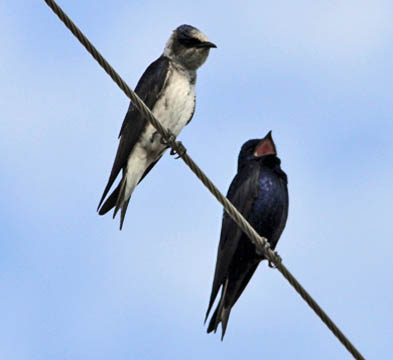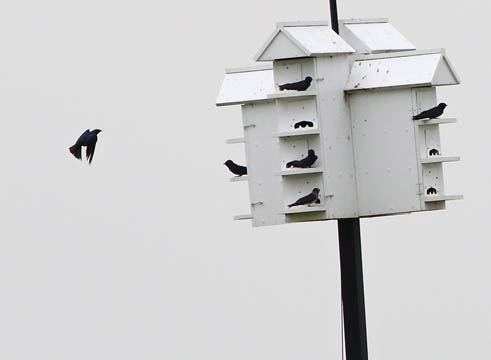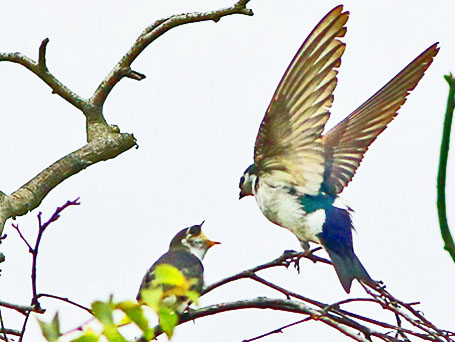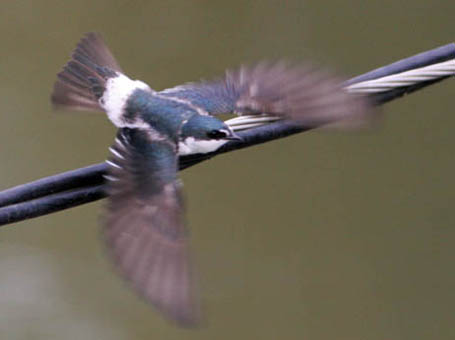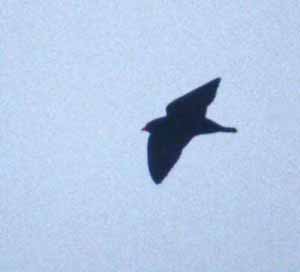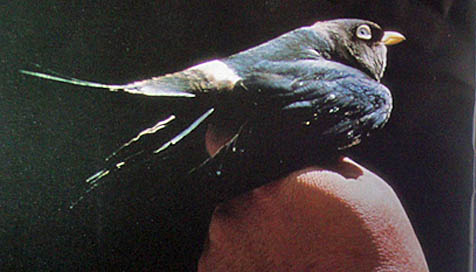
a web page by Don Roberson |
SWALLOWS & MARTINS Hirundinidae |
||||
 |
||||
|
||||
There are nearly 90 species in this family with a wide range of migratory behaviors. Lesser Striped Swallow (left) is an intra-African migrant. Much of the population is resident around the Equator but other populations are wet-season migrants farther north in to the west African Sahel, and in the south to South Africa. It shows two long forks as a tail; indeed, variation in tail shape has led to even greater extremes in swallows such as Wire-tailed Swallow Hirundo smithii, with populations in both Africa and south Asia. One thing often overlooked involves plumage changes from juvenal to adult plumage in some species, like Tree Swallow (below). Young Tree Swallows begin flying as brown birds, when they can be confused with the often-rarer other swallows(see Wilds 1985, Lethaby 1996), but change to the glistening steel-blue color of adults over time. Males change rapidly, but females have a first-summer plumage (Hussel 1983) that is intermediate. This photo (below) shows a juvenal-plumaged Tree Swallow, with the white tertial tips that characterizes young birds, begging from an adult male. |
||||
 |
||||
|
||||
|
||||
The Old World has various brown-colored swallows that are called "Martins." Those inhabiting desert or arid country often breed colonially in burrows, but various dull-colored martins in the Old World tropics build build mud nests on buildings. An example is Rock Martin (right), widespread in tropical Africa and India, photographed here in Tanzania. In the New World, the term "Martin" is reserved for large hole-nesting swallows in the genus Progne. There are nine species breeding from North America to southern South America, most of the them migratory. There are endemic Progne martins in the Galapagos, Cuba, and coastal Peru. All but one species have dark-blue-colored males (some with white bellies) and females that are dingier and with varying degrees of gray or brown (only Brown-chested Martin P. tapera, an intra-continental migrant in South America, lacks blue in male plumage). The most well-known — and the greatest migrant — is Purple Martin (below left; gray-backed, white-bellied female and dark blue male; these are of the desert race hesperia). Purple Martins in western North America breed colonially in dead tress, often using holes drilled by woodpeckers, but the widespread breeder across eastern North America (nominate subis) are not well-adapted to using man-made "martin houses" (below right). Martin houses and breeding martins are a heart-warming part of rural America in the fields and farmlands of the east and mid-west. |
||||
|
||||
| As noted above, Barn Swallow (adult; below left) is a species of almost worldwide distribution. One large population breeds widely in North America and winters in South America; this population is orange below (top photo on this page and below). Another huge populations breeds in Eurasia and then winters in sub-Saharan Africa, and also south Asia to northern Australia; these populations are mostly white below. Banding (ringing) studies have shown that adult Barn Swallows are highly faithful to their breeding sites, with nearly 100% returned for subsequent seasons, while the nestlings they fledge are not nearly so philopatric, with only 0–4% of these returning to the nesting locality the next season. In contrast, studies of Cliff Swallow have shown 45-82% of adult returning to the same nesting site in subsequent years, as do 48-74% of recaptured fledgling the following year (Turner 2004). Violet-green Swallow of pine and oak woodlands of western North America is well-named. Adult males show gloriously vivid violet and forest-green upperparts (the male below, upper right, is about the feed a begging fledgling). The white-rumped Mangrove Swallow (below, lower right) inhabits coastal mangrove and lowland wetlands from southern Mexico to Panama. |
||||
|
||||
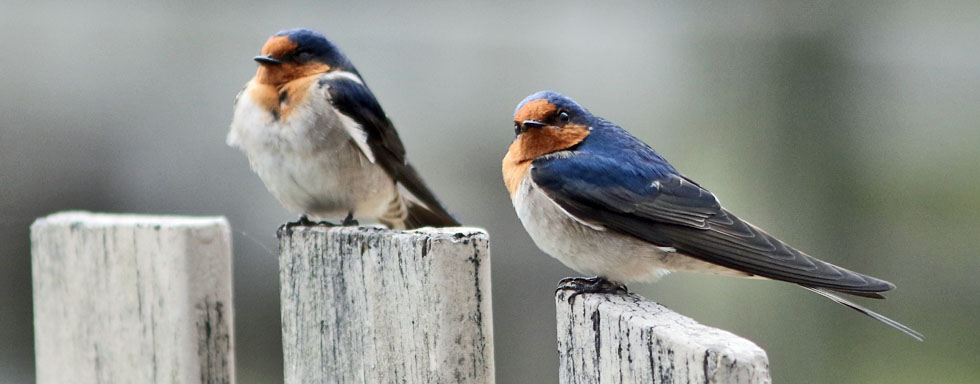 |
||||
In Australia, Welcome Swallow (above) fills the "Barn Swallow" breeding niche. Its plumage recalls that of Old World Barn Swallow but lacks the latter's dark partial to complete breastband. Many hirundines undertake full or partial migrations, bringing vagrants far afield and sometimes leads to range extensions. That happened for Welcome Swallow. Birds from Australia reached New Zealand as vagrants about the 1920s, and then began breeding there in 1958. Since then, Welcome Swallow has become a common breeder on both major New Zealand islands (Turner 2004). |
||||
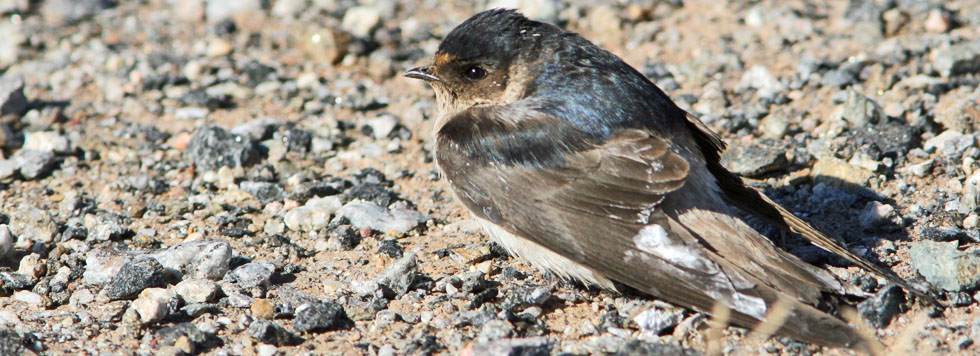 |
||||
| All of the above swallows and martins are in the subfamily Hirundininae, the familiar swallows of the world. Very intriguing are the two species of river-martins in the subfamily Pseudochelidoninae. These are aberrant hirundines with a larger stout bill, robust legs and feet, triangular-shaped wings, and a colored eye-ring around the eye. In flight, the African River-Martin (below, upper left) reminded me of the woodswallows [Artamidae] of SE Asia & Australasia. Until recently, the African River-Martin was a bird of mystery. It appeared and disappeared along large rivers in the Congo Basin. We now know it nests in holes in river banks on the coast in southern Gabon and migrates deep into the interior. Another population breeds in river banks along the Congo River in the remote interior. One is quite lucky to come across a small migrant flock as was this bird (below left; one can barely see the red bill in the original photo — and is lost in this digitized shot). The population sizes of these river-martins are quite small. White-eyed River-Martin Pseudochelidon sirintarae of southeast Asia is even more elusive and is now almost surely extinct. It was similar to African River-Martin except that its eye and eye-ring was white, the bill yellow, it had a white rump band, and two thin and very elongated central rectrices. Its breeding grounds were never known but were thought to perhaps be along rivers in Thailand (Turner & Rose 1989). The species was discovered in 1968 and was named "sirintarae" for Princess Sirindhorn Thepratanasuda of the Thai royal family. When discovered, up to 100 river-martins used a wintering roost on a islet in Lake Bung Boraphet in central Thailand (photo, upper right, below was of a bird netted at that winter roost (© H.E. McClure, as published in Tobias 2000). Ten specimens were obtained in 1968, and six were still at Bung Boraphet in 1978. After that, however, trapping for food and burning at the roost site (to clear for lotus cultivation) decimated the only known location. There are not even rumors after 1986. Today, the White-eyed River-Martin is the iconic image of Bung Boraphet. A huge statute of a giant pair of river-martins greets visitors to Lake Bung Boraphet, which remains an important wetlands for waterbirds in central Thailand (photo below, rvier-martin statute with my wife Rita Carratello). |
||||
|
||||
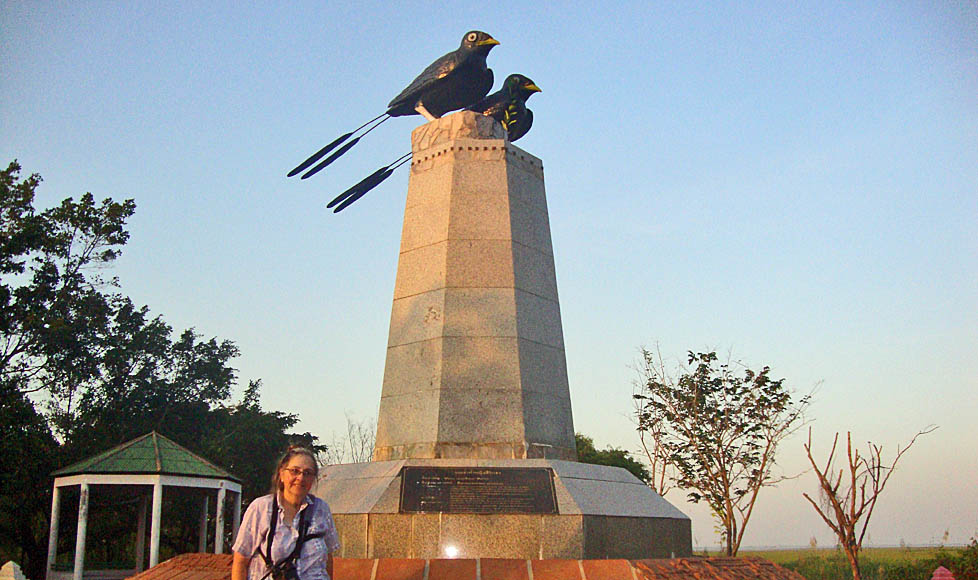 |
||||
Photos: The in-flight Barn Swallow Hirundo rustica was at Salinas, California, USA on 3 May 2008, and the perched adult farther down the page was at Monterey, California, on 3 July 2017. The perched Lesser Striped Swallow Cecropis abyssinica was at Tarangire NP, Tanzania, on 9 June 2018. The adult male and fledgling Tree Swallow Tachycineta bicolor were at Lake El Estero, Monterey Co., California, on 25 June 2020. The breeding biology of Cliff Swallow Petrochelidon pyrrhonota was illustrated by (a) gathering mud at Laguna Grande park, Seaside, California, on 21 Apr 2017; (b) nest-building at Andrew Molera SP, Monterey Co., on 14 May 2005; and (c) feeding young at Salinas, Monterey Co., on 6 July 2019. The two shots of Bank Swallow [Sand Martin] Riparia riparia were from a colony at Ft. Ord SB, Monterey Co., California on 21 June 2008; the Old World example was at the Sharm-el-sheik sewage ponds, Sinai (then occupied by Israel, now Egypt) on 7 Nov 1981. The nesting Rock Martin Ptyonoprogne fuligula was at Gibbs Farm, Tanzania, on 10 June 2018. The pair of Purple Martin Progne subis was near Cascobal, Arizona, on 4 May 2015; the colony of Purple Martins were using a "martin house" at Crane Meadows NWR, Iowa, on 10 June 2017. The adult male and begging young Violet-green Swallow Tachycineta thalassina were In Carmel Valley, Monterey Co., California, on 25 June 2017. The Mangrove Swallow Tachycineta albilinea was along the Rio Rincon, Costa Rica, on 21 Dec 2007. The two Welcome Swallow Hirundu neoxena were at O'Reiily's, Lamington NP, Queensland, Australia, on 1 Sep 2016. The Tree Martin Petrochelidon nigricans was at the Alice wastewater ponds, Northern Territory, Australia, on 18 Aug 2008. The in-flight African River-Martin Pseudochelidon eurystomina was over the Lolo River in central Gabon on 9 July 1996. The in-hand photo of White-eyed River-Martin Pseudochelidon sirintarae was taken by H.E. McClure of a bird captured at Lake Bung Boraphet, Thailand, in Dec 1968 (and published in Tobias 2000); the photo of the river-martin statute at Lake Bung Boraphet was taken on 28 Dec 2012. All photos © Don Roberson, except that of a captured White-eyed River-Martin and © H.E. McClure, as credited and published in Tobias (2000); all rights reserved. Bibliographic essay Family Book: Turner & Rose is in the standard format of whole series of books, many by Pica Press (although this is not), color plates are found separately (with facing page captions) from the text, giving the feeling this is meant to be a field guide. The quality of the paintings is reasonably good, although there is the barest minimum of background (an occasional branch or nest). The introductory text is good, and the species accounts seemed well-researched for biological issues. Yet I was disappointed upon first purchase to find a lack of detail at the "tough" i.d. level (e.g., southwestern Cliff Swallows versus Cave Swallows), some missing distributional records, and the British provincial approach. Books that claim to have a worldwide perspective should not have the English bird called "House Martin" (unmodified) while others are termed "Asian House Martin" and "Nepal House Martin" (particularly when elegant solutions – Asian Martin & Nepal Martin (Clements 1991) or Common House-Martin, Asian House-Martin, Nepal House-Martin (AOU 1998) – exist. Turner & Rose actually apologized for using Barn Swallow over "the Swallow"!! And various "rough-winged" and "cliff" swallows abound unnecessarily. The text may be a fine introduction to worldwide biology in swallows (it did win "Best Book of the Year" in British Birds) but its coverage of distribution or identification may not be entirely up-to-date. When I used it in Africa, I found numerous small distributional errors in the Congo basin region (several species occur in Gabon, for example, that are not mapped there). I suspect the i.d. text is equally insufficient on more obscure species. Perhaps must annoying was the authors' outdated taxonomic perspective. They are "lumpers" and list only 75 species. So while overall it is about what we can be expect these day — an attractive book on the shelf or to flip through with dreams of world birding — it is less than satisfactory in other respects, resulting in this mixed review. [Review written 1999; I note in hindsight that Turner's chapter on swallows & martins in the Handbook of the Birds of the World (Turner 2004) was better in many ways than the stand-alone family book].Other literature cited: American Ornithologists' Union. 1998. Check-list of North American Birds. 7th ed. A.O.U., Washington, D. C.
|
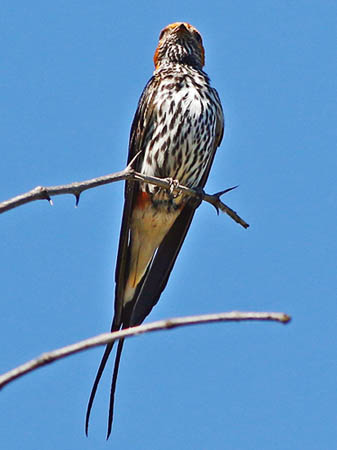 Swallows and Martins — the Hirundinidae — are specialized arboreal insectivores, "instantly recognizable by their slender, streamlined bodies." They are "familiar birds throughout the world, often nesting in close association with people, even inside their homes. They are known to many as harbingers of spring and as symbols of good luck. As a family they are easy to identify, but the family includes many closely related and similar species" (Turner & Rose 1989). Barn Swallow (above) may be the most recognizable of them all, as it breeds widely in the temperate climes of both the Old World and New World, and then winters in the tropics.
Swallows and Martins — the Hirundinidae — are specialized arboreal insectivores, "instantly recognizable by their slender, streamlined bodies." They are "familiar birds throughout the world, often nesting in close association with people, even inside their homes. They are known to many as harbingers of spring and as symbols of good luck. As a family they are easy to identify, but the family includes many closely related and similar species" (Turner & Rose 1989). Barn Swallow (above) may be the most recognizable of them all, as it breeds widely in the temperate climes of both the Old World and New World, and then winters in the tropics.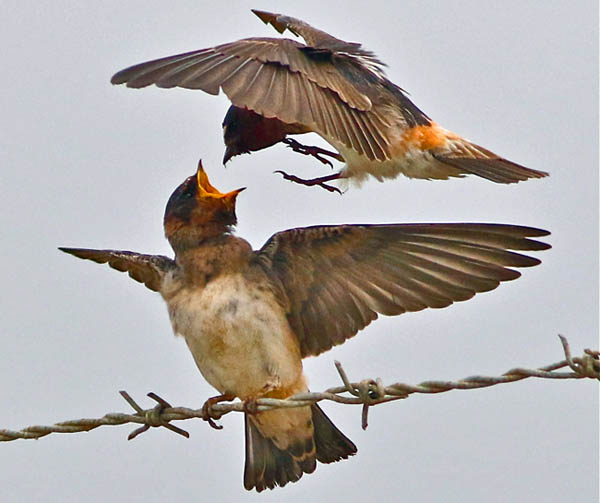
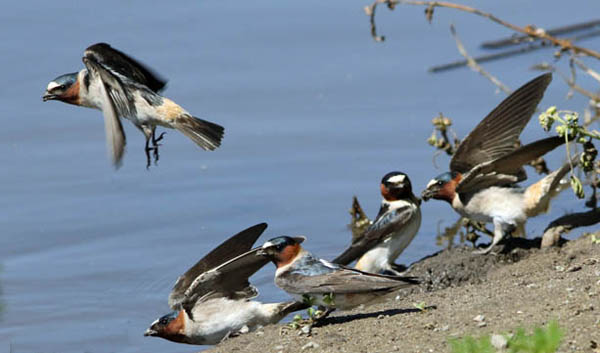
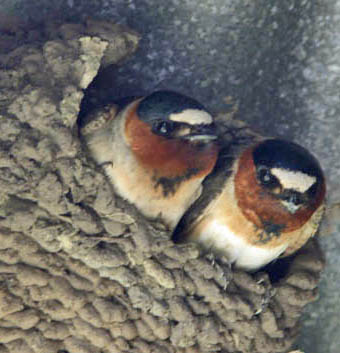
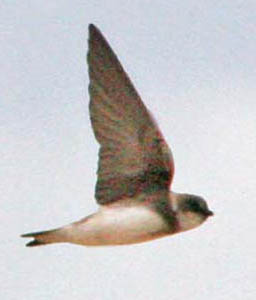


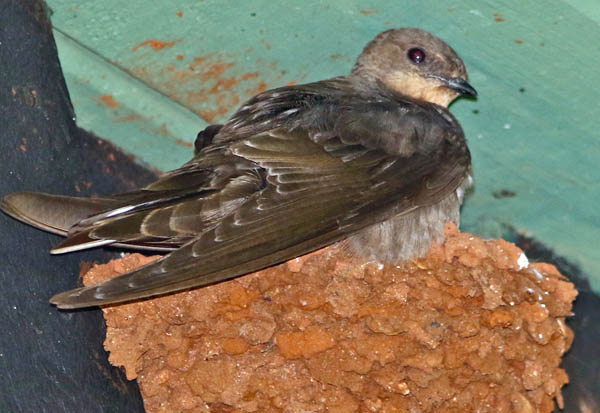 Bank Swallow (above, all 3 shots) has a worldwide distribution; it is known as "Sand Martin" in the Old World (above right, from Sinai). In western North America, Bank Swallow has become a very scarce and local species. All population dig tunnels in vertical sand-banks to create nests. It is not yet understood why California populations are so low — perhaps a loss of appropriate cliffs for nesting? — but these photos (above left & center) show the very last known breeding colony in Monterey County, where I live. It was on a sandy sea-cliff overlooking the Pacific Ocean.
Bank Swallow (above, all 3 shots) has a worldwide distribution; it is known as "Sand Martin" in the Old World (above right, from Sinai). In western North America, Bank Swallow has become a very scarce and local species. All population dig tunnels in vertical sand-banks to create nests. It is not yet understood why California populations are so low — perhaps a loss of appropriate cliffs for nesting? — but these photos (above left & center) show the very last known breeding colony in Monterey County, where I live. It was on a sandy sea-cliff overlooking the Pacific Ocean. 